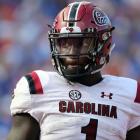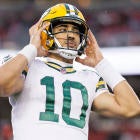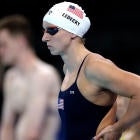In the 2014 NFL Draft, there was an group of wide receivers that featured Odell Beckham Jr., his new teammate Jarvis Landry, Davante Adams, Mike Evans, Brandin Cooks, Sammy Watkins and a handful of other valuable pass catchers. There are a few players from that group that serve as comparisons for the class of 2019 -- which is the best wideout class since that epic group.
Remember this: NFL comparisons for draftees don't intend to guarantee a prospect will have the exact same career as his professional counterpart. In this series, I'll go through the top prospects at every position and give NFL comparisons -- some current players, some former. These comparisons are not based on size. They're almost solely stylistic.
As for the actual draft, you'll be able to stream our live coverage right here on CBS Sports HQ (or download the CBS Sports app for free on any mobile or connected TV device) breaking down all the picks and everything you need to know during draft weekend.
Previous installments: Quarterbacks, Running Backs
(Prospects are listed in the order they appear in my draft rankings.)
A.J. Brown, Ole Miss
NFL comparison: JuJu Smith-Schuster
Smith-Schuster received the second-most targets from the slot in football last season (112) per Sports Info Solutions, and like the young Steelers' star, Brown should land as a big (athletic) slot option in the NFL, no longer a part-time gadget or novelty item. Brown has 4.49 speed but specializes after the catch, when he instantly morphs into a running back. He's also reliable in contested-catch situations. Brown is the most NFL-ready receiver in this class.
Hakeem Butler, Iowa State
NFL comparsion: Plaxico Burress
Outside of Randy Moss, Burress was the matchup nightmare during his time in the NFL at 6-foot-6 and 231 pounds with springy athleticism and a gigantic catch radius. That's the short scouting report on Butler too, and he might be even more dangerous when going after the football at its highest point. The former Iowa State star is a load to bring down after the catch, has experience running a variety of routes, and is bendier than you'd expect for his enormous frame.
JJ Arcega-Whiteside, Stanford
NFL comparison: Mike Evans
Arcega-Whiteside measured in at 6-2 and 225 pounds with 33 1/4-inch arms and 9 1/2-inch hands at the combine. So he's not as monstrous as Evans, who was just under 6-5 and 231 pounds with 35 1/8-inch arms and 9 5/8-inch hands at his combine in 2014. But their playing styles couldn't be more similar. Like Evans, Arcega-Whiteside is a deceptively fast linear wideout with flat-out stupid ball skills. I've called him the best rebounder in this class for months now, and he's dominant in that area. Evans was the same type of overwhelming power forward when he entered the league out of Texas A&M. Arcega-Whiteside isn't totally without lateral mobility either. In some instances, he can pick up yards after the catch.
N'Keal Harry, Arizona State
NFL comparison: Marques Colston
Here's a quote from Drew Brees, featured in an ESPN article, after Colston's first game with the Saints. "He's a big-play receiver. He's a possession receiver, he's a throw-it-up-and-let-him-jump and-get-it receiver." That is precisely the type of pass catcher Harry is, and while he isn't a dazzling, separation creator as a route runner, he is surprisingly nimble after the catch and plays with powerful leg churn to carry defenders for extra yardage as he's finally being tackled. Colston is still the Saints all-time leading receiver and quietly crushed it from his rookie season all the way through his prime with six 1,000-yard campaigns. The big high-pointer finished with an average seasonal stat line of 71 catches, 975 yards, and 7.2 touchdowns in his 10 NFL seasons.
D.K. Metcalf, Ole Miss
NFL comparison: Demaryius Thomas
Let me start by writing Metcalf has more juice than Thomas, but the latter was certainly not a plodder in his prime. Thomas began his career as a large, athletic specimen with a raw game, and it showed. His first two seasons in Denver were pedestrian at their very best. As he learned the intricacies of running routes, Thomas erupted with five-consecutive 1,000-yard seasons. Even as he matured in the NFL, Thomas was best used as a bubble screen, slant, and go-route wideout, and that's precisely how Metcalf needs to be featured to tap into every ounce of his massive talent. Like Thomas too, Metcalf will have the occasional bad drop but come down with circus grabs downfield.
Kelvin Harmon, NC State
NFL comparison: Kenny Golladay
Golladay is a physical, big-bodied presence who thrives down the field because of his frame, catch radius, and ball skills. He's probably a bit more "vertically capable" than Harmon, but as a body control and back-shoulder master, Harmon too can be a downfield threat in the NFL without incendiary speed. Like Golladay did, expect Harmon to start as a second or maybe even a third option early in his pro career before emerging as a true No. 1 by his second or third season mostly because of his intimidating physical presence and reliable hands in traffic.
Marquise Brown, Oklahoma
NFL comparison: Santonio Holmes
Kind of a throwback here, and it's not the more commonly used comparison to DeSean Jackson. Holmes, who's a little bigger than Brown, averaged 18.4 yards per reception with 11 scores in his final season at Ohio State in 2005, almost identical to Brown's average of 18.3 during his two seasons in Norman with the Sooners. Holmes was a sub 4.40 guy as he entered the NFL -- which is around how fast Brown likely is -- and quickly established himself as a serious big-play threat who had some polish to his game with route running and positional flexibility. Brown isn't simply a screen and deep ball target, and he's crafty enough play on the outside and create space before the ball his thrown his way.
Deebo Samuel, South Carolina
NFL comparison: Davante Adams
Adams was a super-productive wideout at Fresno State with Derek Carr, landed in the second round of the 2014 draft, and following some early-career flashes in Green Bay, has become one of the finest young targets in football. He can make the spectacular grab in the red zone, repeatedly turns defenders before and after the catch, and can hit some big-gainers thanks to impressive speed. All of the same is true for Samuel, who arguably possesses the best combination of route-running savvy and yards-after-the-catch skills of any wideout in this class. He boasts strong hands too.
Dillon Mitchell, Oregon
NFL comparison: Keenan Allen
Mitchell is flying considerably under the radar -- big stretch for a Duck pun there -- and he shouldn't be. As everyone turned their attention to Oregon quarterback Justin Herbert in 2018, Mitchell was clearly his go-to target in every game, finishing the year with 75 receptions for over 1,100 yards with 11 touchdowns. He flashed in every way possible ... down the field, in space on underneath routes, and near the sidelines as a chain-mover. He's an ultra-flexible wideout with high-level juking ability to beat press at the line or leave defenders whiffing in the open field. That's the book on Allen too.
Anthony Johnson, Buffalo
NFL comparison: Miles Austin
Austin was a little bigger and more explosive than Johnson, but like the Buffalo star, Austin was a complete wideout during his impressive tenure with the Cowboys. Right when he seemed like an yards-after-the-catch receiver, he'd be found downfield for a 40-yard gain. Johnson isn't spectacular in any area. He's not a liability in any area either. He was a productive go-route pass catcher who tracked it as well as any receiver in college football and showed off awesome contact balance and surprising athleticism after the catch over the past two seasons.
Andy Isabella, UMass
NFL comparison: Brandin Cooks
With 4.31 speed, nifty feet, and a small frame, I couldn't help but slap a Cooks comparison on Isabella. Not to mention, like Cooks at Oregon State, Isabella was an elite producer in college. While he has enough polish to play on the outside, you want him in the slot, which is the case with Cooks too. And both are must-feature players in the screen game because of their acceleration, violent cuts, and top-end speed.
Jakobi Meyers, NC State
NFL comparison: Chris Godwin
Meyers routinely won in contested-catch situations at NC State and had games in which he looked like the Wolfpack's best receiver. While not someone who'll run away from NFL defensive backs, his ball-skill specialization will allow him to carve out an role at the pro level. Godwin has done much of the same in his first two years in Tampa, slowly but surely becoming a favorite target of Jameis Winston. Meyers will likely grow on his quarterback too.
Emanuel Hall, Missouri
NFL comparison: Ted Ginn
All the way back at Ohio State's 2007 Pro Day, Ginn was clocked in the 4.37-4.45 range. If his film with the Buckeyes wasn't convincing enough, his pro day performance showed he was truly a player with sprinter's speed. At this year's combine, Hall ran 4.39 in the 40, recorded a ridiculous 43.5-inch vertical and a 141-inch broad jump -- which landed in the 98th and 99th percentiles at the position respectively. To call Hall "explosive" is an understatement. There's some jagged twitch to his game after the catch, but he can drop perfectly placed passes down the field at times. Doesn't all of that sound like Ginn to you? For as "niche" as the former first-round pick has been during his time in the NFL, he's set to play in his 13th season in 2019.

















